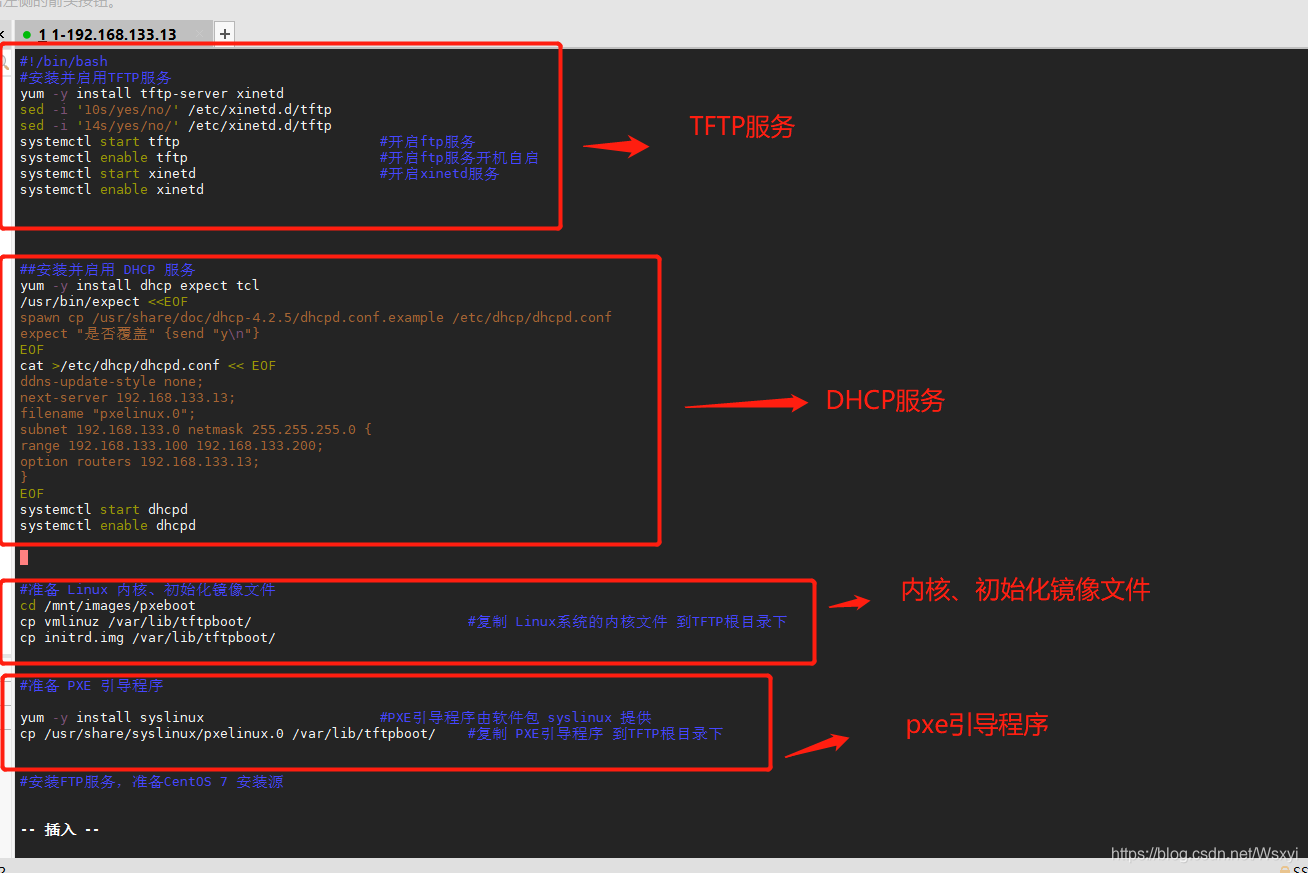shell_一键部署PXE
本文共 1217 字,大约阅读时间需要 4 分钟。
一键部署pxe
一.shell脚本一键部署pxe
#!/bin/bash#安装并启用TFTP服务yum -y install tftp-server xinetdsed -i '10s/yes/no/' /etc/xinetd.d/tftpsed -i '14s/yes/no/' /etc/xinetd.d/tftpsystemctl start tftp #开启ftp服务systemctl enable tftp #开启ftp服务开机自启systemctl start xinetd #开启xinetd服务systemctl enable xinetd##安装并启用 DHCP 服务yum -y install dhcp expect tcl/usr/bin/expect </etc/dhcp/dhcpd.conf << EOFddns-update-style none;next-server 192.168.133.13;filename "pxelinux.0";subnet 192.168.133.0 netmask 255.255.255.0 { range 192.168.133.100 192.168.133.200;option routers 192.168.133.13;}EOFsystemctl start dhcpdsystemctl enable dhcpd#准备 Linux 内核、初始化镜像文件cd /mnt/images/pxebootcp vmlinuz /var/lib/tftpboot/ #复制 Linux系统的内核文件 到TFTP根目录下cp initrd.img /var/lib/tftpboot/#准备 PXE 引导程序yum -y install syslinux #PXE引导程序由软件包 syslinux 提供cp /usr/share/syslinux/pxelinux.0 /var/lib/tftpboot/ #复制 PXE引导程序 到TFTP根目录下#安装FTP服务,准备CentOS 7 安装源yum -y install vsftpdmkdir /var/ftp/centos7cp -rf /mnt/* /var/ftp/centos7/systemctl start vsftpdsystemctl enable vsftpd#配置启动菜单文件mkdir /var/lib/tftpboot/pxelinux.cfgcat >/var/lib/tftpboot/pxelinux.cfg/default <




转载地址:http://hseu.baihongyu.com/
你可能感兴趣的文章
Netty基础—8.Netty实现私有协议栈二
查看>>
Netty多线程 和 Redis6 多线程对比
查看>>
Netty学习总结(2)——Netty的高性能架构之道
查看>>
Netty学习总结(3)——Netty百万级推送服务
查看>>
Netty学习总结(4)——图解Netty之Pipeline、channel、Context之间的数据流向
查看>>
Netty学习总结(5)——Netty之TCP粘包/拆包问题的解决之道
查看>>
Netty学习总结(6)——Netty使用注意事项
查看>>
Netty实现Http服务器
查看>>
Netty客户端断线重连实现及问题思考
查看>>
Netty工作笔记0001---Netty介绍
查看>>
Netty工作笔记0003---IO模型-BIO-Java原生IO
查看>>
Netty工作笔记0006---NIO的Buffer说明
查看>>
Netty工作笔记0007---NIO的三大核心组件关系
查看>>
Netty工作笔记0008---NIO的Buffer的机制及子类
查看>>
Netty工作笔记0009---Channel基本介绍
查看>>
Netty工作笔记0011---Channel应用案例2
查看>>
Netty工作笔记0012---Channel应用案例3
查看>>
Netty工作笔记0013---Channel应用案例4Copy图片
查看>>
Netty工作笔记0014---Buffer类型化和只读
查看>>
Netty工作笔记0015---MappedByteBuffer使用
查看>>